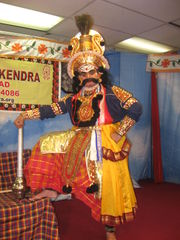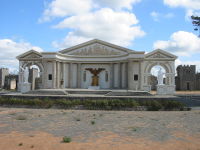Theatre
| Performing arts | |
|---|---|
|
Major forms
|
|
|
Minor forms
|
|
|
Magic · Puppetry |
|
|
Genres
|
|
|
Drama · Tragedy · Comedy · Tragicomedy · Romance · Satire · Epic · Lyric |
|
Theatre (or theater, see spelling differences) is a branch of the performing arts. While any performance may be considered theatre, as a performing art, it focuses almost exclusively on live performers creating a self contained drama.[1] A performance qualifies as dramatic by creating a representational illusion.[2] By this broad definition, theatre had existed since the dawn of man, as a result of the human tendency for storytelling. Since its inception, theatre has come to take on many forms, utilizing speech, gesture, music, dance, and spectacle, combining the other performing arts, often as well as the visual arts, into a single artistic form.
The word derives from the Ancient Greek theatron (θέατρον) meaning "the seeing place."[3]
Contents |
History

The word theatre means "place for seeing".[4] The first recorded theatrical event was a performance of the sacred plays of the myth of Osiris and Isis in 2500 BC in Egypt.[5] This story of the god Osiris was performed annually at festivals throughout the civilization, marking the beginning of a long relationship between theatre and religion.
The ancient Greeks began formalising theatre as an art, developing strict definitions of tragedy and comedy as well as other forms, including satyr plays. Like the religious plays of ancient Egypt, Greek plays made use of mythological characters. The Greeks also developed the concepts of dramatic criticism, acting as a career, and theatre architecture.[6] In the modern world these works have been adapted and interpreted in thousands of different ways in order to serve the needs of the time. Examples are offered by Antigone, used in 1944 by Anouilh to make a statement about the Nazi occupation of France, and by Brecht in 1948, likening Creon to Hitler and Thebes to defeated Germany.[7] The theatre masks of Greek performance became widely adopted in first- and second-century Rome as a decorative theme, both within the home and in public spaces, and representations of two of the forms, of comedy and tragedy, came to stand for the theatre itself: a symbol that survives today.[8]
Western theatre continued to develop under the Roman Empire, in medieval England, and continued to thrive, taking on many alternate forms in Spain, Italy, France, and Russia in the 16th, 17th and 18th centuries. The general trend over the centuries was away from the poetic drama of the Greeks and the Renaissance and toward a more realistic style, especially following the Industrial Revolution.[9] A uniquely North American theatre developed with the colonization of the new world.
The history of Eastern theatre is traced back to 1000 BC with the Sanskrit drama of ancient Indian theatre.[10] Chinese theatre also dates back to around the same time.[11] Japanese forms of Kabuki, Noh, and Kyogen date back to the 17th century AD.[12] Other Eastern forms were developed throughout China, Korea, and Southeast Asia.
The most popular forms of theatre in the medieval Islamic world were puppet theatre (which included hand puppets, shadow plays and marionette productions) and live passion plays known as ta'ziya, where actors re-enact episodes from Muslim history. In particular, Shia Islamic plays revolved around the shaheed (martyrdom) of Ali's sons Hasan ibn Ali and Husayn ibn Ali. Live secular plays were known as akhraja, recorded in medieval adab literature, though they were less common than puppetry and ta'ziya theatre.[13]
Technical aspects of theatre
Theatre is a highly collaborative endeavour. Although the most recognisable figures in theatre are the directors, playwrights, and actors, plays are usually produced by a production team that commonly includes a scenic or set designer, lighting designer, costume designer, sound designer, stage manager, props mistress or master and production manager. Depending on the production, this team may also include a dramaturge, video designer or fight director. The artistic staff is assisted by technical theatre personnel who handle creation and execution of the production.
Types
Drama
Drama (literally translated as action, from a verbal root meaning "To do") is the branch of theatre in which speech, either from written text (plays), or improvised is paramount. A companion word dran, also Greek, means to do. Classical forms of drama, including Greek and Roman drama, classic English drama, notably works of William Shakespeare and Christopher Marlowe, and French drama, for instance works of Molière, are still performed today.
Musical theatre

Music and theatre have always had a close relationship. Musical theatre is a form of theatre combining music, songs, dance routines, and spoken dialogue. Modern musical theatre emerged from the variety, vaudeville, and music hall genres of the late 19th and early 20th century. Musical theatre includes spectacle as well. For instance, contemporary Broadway musicals often include lavish costumes and sets supported by million dollar budgets.
Comedy
Theatre productions that use humour as a vehicle to tell a story qualify as comedies. This may include a modern farce such as Boeing Boeing or a classical play such as As You Like It. Theatre expressing bleak, controversial or taboo subject matter in a deliberately humorous way is referred to as black comedy.
Theatrical philosophy
There is a variety of philosophies, artistic processes, and theatrical approaches to creating plays and drama. Some are connected to political or spiritual ideologies, and some are based on purely "artistic" concerns. Some processes focus on a story, some on theatre as event, and some on theatre as catalyst for social change. According to Aristotle's seminal theatrical critique Poetics, there are six elements necessary for theatre: Plot, Character, Idea, Language, Music, and Spectacle.[14] The 17th century Spanish writer Lope de Vega wrote that for theatre one needs "three boards, two actors, and one passion".[15] Others notable for their contribution to theatrical philosophy are Konstantin Stanislavski, Antonin Artaud, Bertolt Brecht, Orson Welles, Peter Brook, and Jerzy Grotowski.
Konstantin Stanislavski is considered to be the father of theater technique, as he was the first person to ever write about it, and the majority of modern western theatre theory is derived from Stanislavski's "system" in one form or another.[16] Many of Stanislavski's students rejected his system and began to create their own, these first new methods helped to blaze the way for future theorists and ultimately lead to the wide range of techniques that are studied and used today: such as the Meisner, Stanislavsky, Strasberg, and Hagen acting methods.
Theatre organization and administration
There are many modern theatre movements which go about producing theatre in a variety of ways.

Theatrical enterprise varies enormously in sophistication and purpose. People involved vary from professionals to hobbyists to spontaneous novices. Theatre can be performed with no money at all or on a grand scale with multi-million dollar budgets. This diversity manifests in the abundance of theatre sub-categories, which include:
- Broadway theatre and West End theatre
- Community theatre
- Dinner theatre
- Educational theatre
- Fringe theatre
- Off-Broadway and Off West End
- Off-Off-Broadway
- Regional theatre
- Summer stock theatre
Repertory companies
While most modern theatre companies rehearse one piece of theatre at a time, perform that piece for a set "run", retire the piece, and begin rehearsing a new show, repertory companies rehearse multiple shows at one time. These companies are able to perform these various pieces upon request and often perform works for years before retiring them. Most dance companies operate on this repertory system. The Royal National Theatre in London performs on a repertory system.
Producing vs. presenting

In order to put on a piece of theatre, both a theatre company and a theatre venue are needed. When a theatre company is the sole company in residence at a theatre venue, this theatre (and its corresponding theatre company) are called a resident theatre or a producing theatre, because the venue produces its own work. Other theatre companies, as well as dance companies, do not have their own theatre venue. These companies will therefore either perform at rental theatres or at presenting theatres. Both rental and presenting theatres have no full time resident companies. They do, however, sometimes have one (or multiple) part time resident companies, in addition to other independent partner companies who arrange to use the space when available. A rental theatre allows the independent companies to seek out the space, while a presenting theatre seeks out the independent companies to support their work by presenting them on their stage.
However, many performance groups have challenged the theatre-space and have since been putting on work in non-theatrical spaces. These performances can take place outside or inside, in a non-traditional performance space, and include street theatre, and site specific theatre.
A touring company is an independent theatre or dance company that travels, often internationally, being presented at a different theatre in each city.
Unions
There are many theatre unions including Actors Equity Association (for actors and stage managers), the Stage Directors and Choreographers Society (SDC), and the International Alliance of Theatrical Stage Employees (IATSE, for designers and technicians). Many theatres require that their staff be members of these organizations.
See also
- Acting
- Art
- Alternative theatre
- Culinary theatre
- Fiction
- Employment in theatre
- List of awards in theatre
- List of notable theatre festivals
- List of playwrights
- List of theatre directors
- Movie theatre
- Outline of theatre
- Performance art
- Reader's theatre
- Theatre consultant
- Theatre for development
- Theater (structure)
- Theatre technique
- Theatrical style
References
- ↑ Encyclopedia Britannica, Volume 28 page 521
- ↑ Encyclopedia Britannica, Volume 28 page 561
- ↑ http://www.omnipelagos.com/entry?n=theatre
- ↑ Theatre. 1911 Encyclopedia Britannica, Volume V26, p. 729.
- ↑ Stanton, Sarah; Banham, Martin (1996). "Middle East and North Africa". Cambridge paperback guide to theatre. Cambridge, England: Cambridge University Press. p. 241. ISBN 0-521-44654-6.
- ↑ Ward, A. C. (2007). Specimens of English Dramatic Criticism. Read Books. p. 1.
- ↑ McDonald, Marianne (2003). The living art of Greek tragedy. Bloomington, IN: Indiana University Press. pp. 80–81. ISBN 0253215978.
- ↑ McCart, Gregory (2007). "Masks in Greek and Roman Theatre". In McDonald, Marianne. The Cambridge companion to Greek and Roman theatre. Cambridge, England: Cambridge University Press. pp. 265–266. ISBN 0-521-83456-2.
- ↑ Kuritz, Paul (1988). The making of theatre history. PAUL KURITZ. p. 305. ISBN 978-0-13-547861-5.
- ↑ Dhingra, Baldoon (1944). A national theatre for India. Padma Publications ltd. p. 6.
- ↑ Chinese performing arts. Encyclopædia Britannica.
- ↑ Deal, William E. (2007). Handbook to life in medieval and early modern Japan. Oxford University Press US. p. 276. ISBN 978-0-19-533126-4.
- ↑ Moreh, Shmuel (1986). "Live Theater in Medieval Islam". In David Ayalon, Moshe Sharon. Studies in Islamic History and Civilization. Brill Publishers. pp. 565–601. ISBN 965264014X
- ↑ Hatcher, Jeffrey (2000). The art & craft of playwriting. Writer's Digest Books. p. 21. ISBN 978-1-884910-46-3.
- ↑ Gloman, Chuck B.; Napoli, Rob (2007). Scenic design and lighting techniques: a basic guide for theatre. Focal Press. p. 17. ISBN 978-0-240-80806-2.
- ↑ Roose-Evans, James (1984). Experimental theatre from Stanislavsky to Peter Brook. Routledge. p. 6. ISBN 978-0-7100-9954-9.
External links
- Theatre Archive Project (UK) British Library & University of Sheffield.
- Theater Wikia - An editable database dedicated to all aspects of theatre.
- University of Bristol Theatre Collection
- Music Hall and Theatre History of Britain and Ireland
